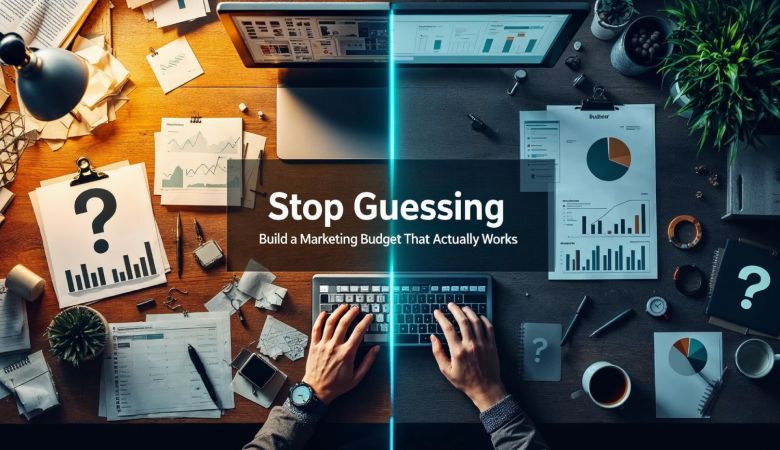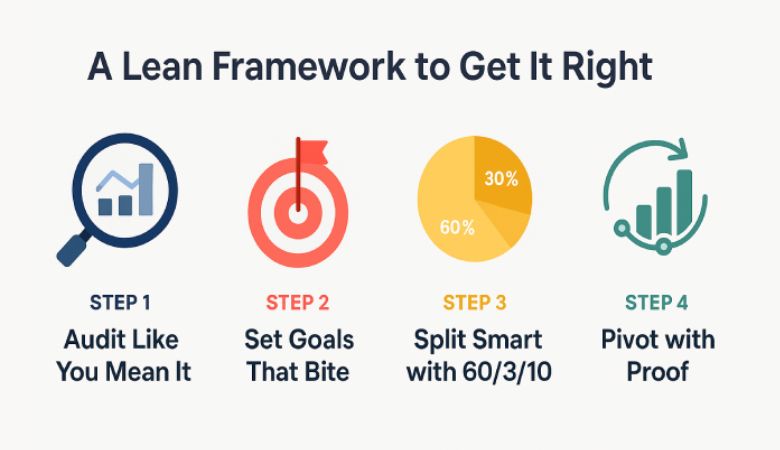Stop Guessing: Build a Marketing Budget That Actually Works
Digital marketing can feel like throwing darts in the dark—plenty of options, not enough clarity. For small businesses and startups, every dollar counts, yet the path to growth often gets buried under buzzwords and bad bets. With over eight years in the trenches and 500+ projects under my belt, I’ve learned one truth: a smart marketing budget isn’t optional—it’s your lifeline to results.
This isn’t about flashy tools or endless ad spend. It’s about a no-nonsense framework that turns limited resources into real wins, whether you’re a retailer chasing sales or a service startup building a name. Forget the vague promises—here’s how to make your budget work harder, backed by data, grit, and a little rebellion against the hype.
Why Your Budget Isn’t Just a Number
A marketing budget isn’t a chore—it’s your battle plan. The Content Marketing Institute found that businesses with a clear budget strategy boost campaign efficiency by 30%. That’s not luck; it’s focus. For a small business with $5,000 to spend, it’s the difference between scattered efforts and a laser-sharp push that doubles traffic. Without it, you’re bleeding cash on channels that don’t convert or starving ones that could.
Think of it as a filter: it forces you to pick winners, ditch losers, and stop chasing every shiny trend. Done right, it’s how a startup beats the odds or an e-commerce shop turns browsers into buyers.
A Lean Framework to Get It Right
Here’s a four-step playbook tailored for small businesses and startups. No fluff—just what works.
Step 1: Audit Like You Mean It
Don’t just glance at your spending—dig in. Pull up Google Analytics and check your last six months: organic traffic sources, bounce rates (over 60% is a red flag), and conversion rates (under 2% means trouble). Cross-reference with your ad spend—say, $500 on Facebook ads—and calculate cost-per-click (CPC). If it’s $3 with no sales, that’s a clue. Use this 5-point checklist:
- Traffic: Where’s it coming from? (e.g., 70% Google, 20% social)
- Engagement: Are users sticking around? (Time on page <30 seconds is bad)
- Conversions: What’s turning clicks into cash? (Forms, checkouts)
- Costs: What’s each channel costing you? (CPC, tool subscriptions)
- Gaps: What’s missing? (e.g., no mobile optimization)
This isn’t busywork—it’s your baseline. A client once found 80% of their budget went to underperforming Instagram ads; shifting to SEO cut costs and tripled leads.
Step 2: Set Goals That Bite
Vague goals sink budgets. A startup doesn’t need “more traffic”—it needs 1,000 visitors in 90 days to pitch investors. An e-commerce shop wants 50 extra sales monthly, not just “growth.” Tie goals to your reality: if your average sale is $50, a 20% cart completion boost means $10,000 more revenue. Know your audience too—small business owners crave simplicity, so prioritize clear messaging over tech overload.
Step 3: Split Smart with 60/30/10
The classic 70/20/10 model works, but for lean budgets, tweak it: 60/30/10. Here’s why and how:
- 60% to What Wins: Put most cash where results are proven. For $5,000, that’s $3,000 on SEO (e.g., $1,500 for content, $1,500 for technical fixes) or an email marketing template builder ($200-$500) if your list converts at 3%. Small businesses live or die by efficiency—don’t gamble here.
- 30% to What’s Next: Test what’s promising but unproven—$1,500 on Google Ads targeting “buy now” keywords or a short video series. If it flops, you’ve learned without breaking the bank.
- 10% to What’s Wild: Throw $500 at a risk—say, a chatbot or Reddit ads. Startups thrive on bold moves; this is your swing.
Why 60/30/10? Small budgets can’t afford 20% experiments—30% keeps you agile without starving the core.
Step 4: Pivot with Proof
Data isn’t decoration—it’s your compass. Track weekly: if Google Ads hit 5% CTR but zero sales, your landing page sucks—fix it with a landing page builder and email marketing system ($50-$100/month). If email open rates drop below 15%, test subject lines (e.g., “Your Next Sale” vs. “Save Now”). A/B test everything; one tweak doubled a client’s conversions from 1% to 2.2%. Adjust fast—stagnation kills.
Where to Put Your Money (and Why)
Small businesses need bang for buck. Here’s where to focus, with real trade-offs.
SEO: Your Long Game
Organic search drives 53% of traffic (BrightEdge, 2023)—skip it, and you’re invisible. Spend on long-tail keywords—“affordable CRM for startups” beats “CRM”—and fix site speed (under 2.5 seconds per Google’s Core Web Vitals). Budget $500-$1,000 for tools like Ahrefs ($99/month) and a writer. Trade-off: it’s slow—expect results in 3-6 months, not tomorrow.
PPC: Your Quick Hit
Google Ads can deliver leads in days, not months. Target high-intent terms (“buy organic soap”) for $1-$3 CPC; $1,000 gets 300-1,000 clicks. Pair with a landing page builder and email marketing tool to convert 2-5%. Trade-off: it’s pricey—$1,500 monthly burns fast if your offer’s weak.
Email: Your Cash Cow
Litmus pegs email ROI at $36 per $1—small businesses can’t ignore that. Use an email marketing template builder like Mailchimp ($13-$50/month) for welcome emails (20%+ open rates) or cart recovery (10%+ conversions). Trade-off: needs a list—build one first via free content or ads.
Web: Your Foundation
A slow, clunky site tanks everything. Budget $1,000-$3,000 for mobile optimization (50% of users are mobile) and basic SEO markup. E-commerce? Add $500 for secure checkout. Trade-off: upfront cost hurts, but a 1-second delay cuts conversions by 7% (Google data).
Skip the App (For Now)
Apps sound sexy, but a $10,000 iOS/Android build is overkill for most startups. Stick to a marketing content management system ($50-$200/month) for web-first growth. Trade-off: apps lock in loyalists later—focus on acquiring them first.
Budget Traps (and How to Dodge Them)
Small budgets magnify mistakes. Here’s what trips you up—and how to fight back.
Chasing Every Channel
A $2,000 budget split five ways ($400 each) is noise, not impact. Pick one—SEO at $1,500—and own it. A digital marketing agency template maps this: list channels, rank by ROI, cut the bottom half. One client ditched Twitter ads for email, lifting revenue 25%.
Ignoring the Messy Middle
Short-term wins (PPC) feel good, but long-term plays (SEO) build equity. Balance them—$3,000 on ads now, $2,000 on content for later. A retailer who skipped SEO for ads saw sales plateau; adding it grew traffic 80% in year two.
Freezing When Cash Dries Up
Budgets shrink—deal with it. If $5,000 drops to $3,000, cut wildcards (10%) and trim tests (30% to 20%). Keep the 60% core—SEO or email—intact. A startup I know halved ad spend, doubled down on content, and still hit 90% of their goal.
Proof It Works (Warts and All)
A retailer started with $5,000: $3,000 on SEO (site fixes, blogs), $1,500 on PPC (product ads), $500 on a chatbot. Six months in, traffic jumped from 2,000 to 5,000 visits, sales rose $10,000 to $20,000 monthly—but the chatbot flopped, costing $500 for 10 chats. Lesson? Core tactics won; the wildcard didn’t.
Another case: a service startup blew $2,000 on scattershot social ads—20 platforms, zero focus. Conversions tanked at 0.5%. They pivoted to $1,500 on SEO and $500 on email, hitting 1,200 visitors and 15 clients in four months. Failure taught them: narrow beats broad.
Tools That Don’t Waste Your Cash
Spend smart on these:
- Google Analytics: Free. Tracks traffic, bounces—your audit starter.
- Ahrefs: $99/month. Finds keywords competitors miss—worth it for SEO.
- Mailchimp: $13-$50/month. Email marketing template builder with automation—beats Constant Contact for price.
- WP Rocket: $49/year. Speeds up WordPress sites—cheaper than a new host.
Why these? Ahrefs beats SEMrush for keyword depth at a lower tier; Mailchimp’s free tier scales better than rivals. Test them—ditch what doesn’t click.
Google’s Rules, Your Edge
Google loves depth—E-E-A-T (expertise, experience, authoritativeness, trustworthiness) isn’t jargon; it’s your ticket to rank. Write what you know (like this), cite real data (BrightEdge, Litmus), and skip stuffing the marketing budget unnaturally. AI? Fine for drafts—human polish makes it sing.
Partner with our Digital Marketing Agency
Ask Engage Coders to create a comprehensive and inclusive digital marketing plan that takes your business to new heights.
Wrap-Up: Stop Winging It
A marketing budget isn’t a luxury—it’s how small businesses and startups survive. The 60/30/10 split, ruthless audits, and hard choices beat guesswork every time. You don’t need a fortune—just a plan. Test this framework with $1,000 or $10,000; tweak it when it breaks. Want to talk it through? Engage Coders has seen these moves win—we’re here to hash it out. Your next step’s yours.








